American Cars of the Fifties
Article by Mark Trotta
Large, roomy, and comfortable, huge chrome bumpers, big V8 motors, two and three-tone paint schemes - these are American cars of the fifties!

Once regarded as mere transportation vehicles, cars after World War II became symbols of middle-class affluence. Automotive styling began taking on a second role as a marketing device (including planned obsolescence). Safety and economy often took a back seat to power, comfort, and style.
The post WW2 years saw an amazing amount of new models with creature comforts never before dreamed of.
Early Fifties Cars
The hardtop convertible combined the open-air feel of a convertible with the comfort of a closed car. Introduced on 1950 models, the hardtop saw a rise in popularity in 1951. Some manufacturers mounted a steel top to a convertible body, adding the benefits of the stiffer convertible frame.

Steel Body Alternatives
Because of restrictions put on metals during the Korean Conflict of 1950-1953, U.S. carmakers started experimenting with other materials to make car bodies out of. These included aluminum, magnesium, plastic, and fiberglass. And just like the very first automobiles, several companies designed and built wooden-bodied cars.
Concept Cars of the Fifties

Actually driven by GM design boss Harley Earl, the jet fighter-inspired Le Sabre dream car featured an aluminum and magnesium body, heated seats, and built-in hydraulic jacks. Mounted on the center console was a water sensor, which automatically raised the top and all window glass if it started to rain.
GM Motorama Exhibit
Along with an orchestra, dancers, and singers, many exciting concept cars were introduced at GM Motorama auto shows, such as the Buick Wildcat, Pontiac La Parisienne, Oldsmobile Starfire, Firebird XP-21 and the Cadillac El Camino.

At the 1953 GM Motorama in New York City, the fiberglass-bodied Corvette was an overwhelming favorite. The Chevrolet Corvette went into production a short six months later.
1953-1954 American Cars
After two years of war-time shortages and restrictions, the U.S. Government's relaxation of controls on steel, copper and aluminum made 1953 a promising year for auto-makers.
As American passenger cars got bigger, power steering gained popularity.
By 1953, more than 50% of all new U.S. models were equipped with some form of automatic shift.
First seen on 1940 Packard models, factory-installed air-conditioning was now available as optional equipment by several carmakers.
Starliner Hardtop And Starlight Coupe
Widely agreed upon as one of the best designs of the decade, the aerodynamic shape of the 1953 Studebaker Starliner and Starlight models was unlike anything seen before.
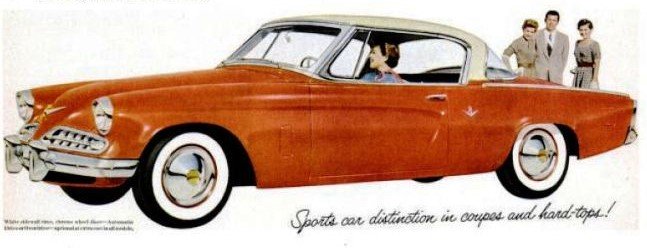
1955 Chrysler 300
Big, quick, and luxurious, the Chrysler C-300 was powered by a 331 cubic-inch Hemi V8 producing 300-horsepower.

The 4,000 pound car was based on the New Yorker model, boasting leather upholstery and other upgrades as standard equipment.
1955 Ford Thunderbird
Development of the Ford Thunderbird began in February of 1953, just one month after Chevrolet debuted their Corvette concept car at the GM Motorama in New York.

Ford would use parts off existing models for their new car, as did Chevy. Ford would also copy the long-nose/short-tail and 102-inch wheelbase of the Jaguar XK120 as did Chevy. But similarities ended there - Ford's answer to the Corvette was not a no-frills sports car, but rather a stylish, more practical personal-luxury car.
Tri-Five Chevys
Available in 150, 210, and Bel Air models, the 1955 Chevrolet was new from the ground up, including frame, suspension, exterior, and a hot new V8 engine.

The 265ci Chevy V8 was an immediate success. Originally producing 162 horsepower, a second, higher-output version was offered soon after. With the addition of a four-barrel carb and some minor tweaking, power output increased to 180 horsepower.

Read: Chevy Small-Block History 1955-1959
In addition to upgrades like 6-volt to 12-volt electrical system, 1955 Chevy models could be ordered with air conditioning, power windows, power steering, power brakes and even power seats. Never before had so many options been offered on a car in the low-price field.
Over 1.7 million Chevy's were produced in 1955, which accounted for nearly 23% of all American car sales in the U.S. that year.
Minor changes for 1965 included new engine options, revised dash, and hidden gas-filler cap in the rear fin.

A minor re-style on the 1957 Chevy saw a slightly longer and heavier car, with sales just over 1.5 million.

1955/1956/1957 Chevrolet models continue to be favorites with hot-rodders and classic car enthusiasts. Many rate the 1957 Chevy as one of the best cars of the fifties. Despite that fact, Ford outsold Chevy in 1957, the first time since 1935.
========================
Ford and Chevrolet accounted for fully half of American car production in 1957.
========================
Orphan Cars Of The Fifties
While the "Big Three" (General Motors, Ford Motor Company and Chrysler Corporation) fought to keep their top spots, there were many smaller U.S. car manufacturers.
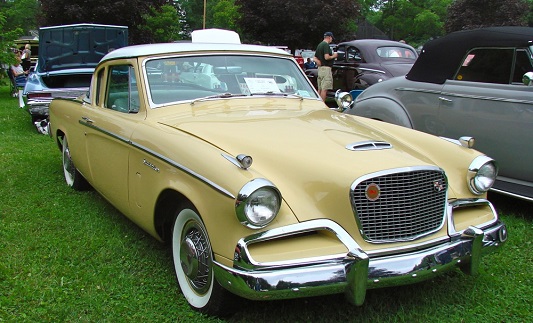
Hudson, Kaiser-Frazer, Nash, Packard, Studebaker, and Willys were all fighting for their share of sales, and managed to water down market share for GM, Ford and Chrysler. Many of these smaller car companies brought innovative features to the car buying public.
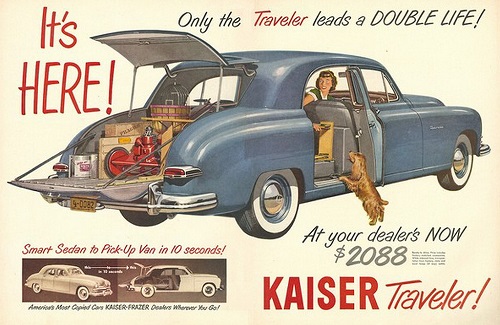
Pictured: Kaiser Traveler hatchback
========================
Mergers
After phasing out Frazer models by the end of 1951, Kaiser acquired Willys Overland Motors in 1953, but succumbed to market pressure and moved its operations to South America.
Looking for larger sales and combined manufacturing to compete with the "Big Three", Studebaker merged with Packard Motor Company in 1954. Studebaker survived the decade with a resurgence in sales in 1959, and would continue making cars until 1966.

Nash Motors and Hudson merged in 1953 to form American Motors Corporation. Nash production ended in June of 1957 with 1958 models selling under the Rambler name.
========================
Quad Headlamps
In 1957, not all states had accepted the use of four headlamps, but by 1958, they were legal in all 50 states. Quad headlamps, mounted either vertically or horizontally, showed up on nearly every American make and model, including trucks.

Pictured: 1957 Nash with quad headlamps
========================
1958 Economic Recession
A mild recession occurred at the end of 1957, effecting the United States, Canada, and Europe. In 1958, total U.S. car sales dropped 31% from the prior year. Just two cars showed a sales increase that year, Ford Thunderbird and Rambler.
As the year ended, the economy picked up, and automotive production was soon hitting new peaks.
========================
The Edsel
For the 1958 model year, a new line of cars was introduced by Ford Motor Company. It was to be an intermediate-priced car between budget-priced Ford and upper-end Mercury.
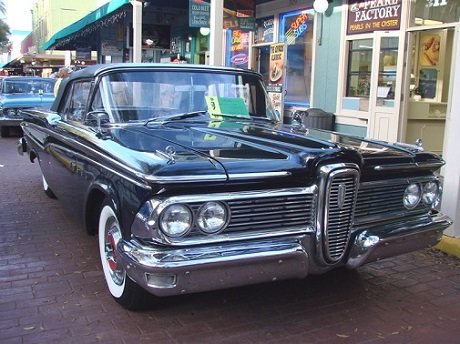
After over-saturating television and radio with outlandish claims and advertising hoopla, less than 85,000 cars were sold after three years. Ford lost millions of dollars it had invested in research and development, forever marking the Edsel as one of America's most famous marketing disasters.
Was Edsel Really A Bad Car?
Aside from minor first-year model complaints, there were no major mechanical issues with the Edsel. The body styling may seem radical today, but at the time was merely 'distinctive'.

The Edsel's failure, and it's ultimate bad reputation, was mostly the result of bad marketing.
========================
Retractable Hardtop
From 1957 to 1959, Ford produced over 48,000 Skyliners, which featured a retractable hardtop. The mechanism included ten power relays, four lock motors, three drive motors, eight circuit breakers, and about 600 feet of electrical wire.

Although complex, the retractable top was actually reliable for it's day.
========================
Longer Wider Heavier
The year 1958 saw larger and heavier cars with larger and heavier V8 motors. This included the 364ci Buick and the 365ci Cadillac. Chrysler released their 392ci engine in 1957, and the venerable 383ci engine in 1959.
The 1959 Lincoln Continental, built on a unit-body/frame, weighed 5,500 pounds, and was powered by a 430ci big-block V8. Famous fifties celebrities who owned one included Dwight Eisenhower, Elvis Presley, and Frank Sinatra.

Stretching nearly 19 feet long and 80 inches across, third-generation Continentals were the largest Lincolns ever, as well as one of the largest cars ever produced. They were also the roomiest, with 44 inches of leg-room up front and 44.9 inches in the rear.
========================
Tallest Tail Fins
Tail fins, both vertical and horizontal, were at their peak in the late fifties.

The huge tail fins with dual-bullet taillights on 1959 Cadillac models were designed by Peter Hodak, and are generally considered to be the epitome of fifties automotive styling. They were the tallest tail fins ever put on a production car.
========================
Throughout the fifties, creature comforts such as power brakes, power steering, electric front seats and windows, and air conditioning, all increased in popularity. By 1958, over 80% of American cars were equipped with automatic transmissions.
========================
Compact Cars of the Fifties
Post WW2 America enjoyed a booming economy, with cheap gas and bigger and faster cars. During this time, car manufacturers found that American consumers had little interest in compact cars.
Although popular early-on in Europe, the VW Beetle was slow to catch on in America. In 1949-1950, Volkswagen sold just two Beetles in the U.S. That number increased to 551 cars in 1951, and 601 cars in 1952.
Kaiser Henry J (1951-1954)
Presented for sale in September 1950, the 1951 Henry J was priced at $1300, which was lower than other cars in it's category. This was part of an agreement from a government loan that helped finance the little car's development.

Other American-built compact cars of the fifties include the Willys Aero (1952-1954), and the Hudson Jet (1953-1954).
Crosley Microcars
While Crosley cars were not a financial success, they were Microcar pioneers in the North American market.

Crosley cars introduced several automotive firsts, including the first mass-market single overhead camshaft (SOHC) engine, and first American car manufacturer to use modern disc brakes. Over 14 years of production, Crosley Motors sold 24,871 vehicles.
Nash Metropolitan
American-designed and British-built, the Nash Metropolitan measured less than 13 feet long, and is often called America's first subcompact car. Production began in October 1953, with the first shipment of cars arriving to the U.S. several months later.

Over an eight year span, over 95,000 Metropolitans were produced and sold under the marques of Hudson, Nash, Rambler, and AMC.
After the economic recession of 1958, interest in smaller cars slowly began to grow. U.S. built compact cars soon included the 110" wheelbase Studebaker Lark, which debuted in 1959. In 1960, Detroit's Big Three would offer their small cars; the Chevy Corvair, Plymouth Valiant and Ford Falcon.
========================
In 1950, there were 40 million cars registered in the United States. By the end of the decade, that number nearly doubled.
Today, the Chrysler 300, Chevy Impala and the Corvette are still with us, and retractable hardtops have made a comeback.
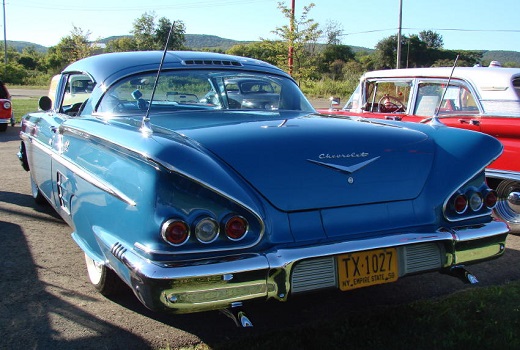
It's a shame the fifties only lasted 10 years...
***************************
Related Articles: